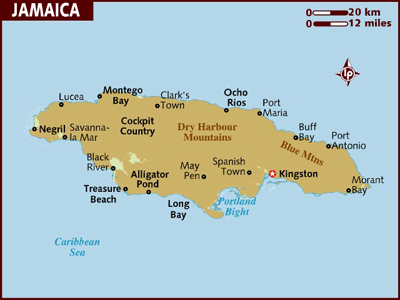JAMAICA

Geography
Jamaica is an island in the West Indies, 90 mi (145 km) south of Cuba and 100 mi (161 km) west of Haiti. It is a little smaller than Connecticut. The island is made up of coastal lowlands, a limestone plateau, and the Blue Mountains, a group of volcanic hills, in the east.
Government
Constitutional parliamentary democracy.

History
Jamaica was inhabited by Arawak Indians when Columbus explored it in 1494 and named it St. Iago. It remained under Spanish rule until 1655, when it became a British possession. Buccaneers operated from Port Royal, also the capital, until it fell into the sea in an earthquake in 1692. Disease decimated the Arawaks, so black slaves were imported to work on the sugar plantations. During the 17th and 18th centuries the British were consistently harassed by the Maroons, armed bands of freed slaves roaming the countryside. Abolition of the slave trade (1807), emancipation of the slaves (1833), and a drop in sugar prices eventually led to a depression that resulted in an uprising in 1865. The following year Jamaica became a Crown colony, and conditions improved considerably. Introduction of bananas reduced dependence on sugar.
On May 5, 1953, Jamaica gained internal autonomy, and, in 1958, superheaded the organization of the West Indies Federation. A nationalist labor leader, Sir Alexander Bustamente, later campaigned to withdraw from the federation. After a referendum, Jamaica became independent on Aug. 6, 1962. Michael Manley, of the socialist People's National Party, became prime minister in 1972.
Best time to visit
Consistently warm tropical weather ensures Jamaica is a popular destination year-round. On the coast, temperatures range from 22°C (72°F) and 31°C (88°F) with chilly mornings and evenings denoting winter. Peak season runs roughly from mid-December to mid-April when crowds swell and prices rise. The wettest months are May and October, but showers may occur at any time. Between June and November, Jamaica is prone to hurricanes. It also lies within the earthquake zone.
The annual rainfall averages 1980mm, but nationwide there are some considerable variations, with the east coast receiving considerably more rain than elsewhere on the island. Parts of the Blue Mountains receive an average of 7620mm a year. By contrast, the south coast sees little rain and in places is semi-barren. Jamaica is a year-round destination, though there are seasonal differences to consider. Weather-wise, temperature isn’t an important factor: winter is usually warm by day and mild to cool by night, and summer months are simply hot.
Pack lightweight cottons and casual linens. Light woollens are advised for evenings when mosquitoes can make long sleeves more appealing than skimpy beachwear. Sunhats and waterproofs are handy all year round.

